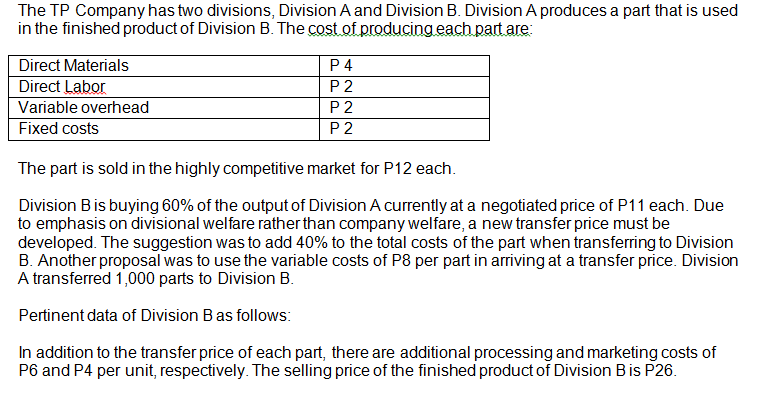Determine the gross profit per unit for Division B based on the following transfer pricing method: 1. Gross profit per unit for Division B under Variable product cost method 2. Gross profit per unit for Division B under Full product cost plus 40% mark-up based on cost method 3. Gross profit per unit for Division B under Negotiated price method
Determine the gross profit per unit for Division B based on the following transfer pricing method: 1. Gross profit per unit for Division B under Variable product cost method 2. Gross profit per unit for Division B under Full product cost plus 40% mark-up based on cost method 3. Gross profit per unit for Division B under Negotiated price method
Cornerstones of Cost Management (Cornerstones Series)
4th Edition
ISBN:9781305970663
Author:Don R. Hansen, Maryanne M. Mowen
Publisher:Don R. Hansen, Maryanne M. Mowen
Chapter10: Decentralization: Responsibility Accounting, Performance Evaluation, And Transfer Pricing
Section: Chapter Questions
Problem 4CE
Related questions
Question
Determine the gross profit per unit for Division B based on the following transfer pricing method:
1. Gross profit per unit for Division B under Variable product cost method
2. Gross profit per unit for Division B under Full product cost plus 40% mark-up based on cost method
3. Gross profit per unit for Division B under Negotiated price method

Transcribed Image Text:The TP Company has two divisions, Division A and Division B. Division A produces a part that is used
in the finished product of Division B. The cost of producing each part are:
Direct Materials
Direct Labor
Variable overhead
Fixed costs
P 4
P 2
P 2
P2
The part is sold in the highly competitive market for P12 each.
Division Bis buying 60% of the output of Division A currently at a negotiated price of P11 each. Due
to emphasis on divisional welfare rather than company welfare, a new transfer price must be
developed. The suggestion was to add 40% to the total costs of the part when transferring to Division
B. Another proposal was to use the variable costs of P8 per part in arriving at a transfer price. Division
A transferred 1,000 parts to Division B.
Pertinent data of Division Bas follows:
In addition to the transfer price of each part, there are additional processing and marketing costs of
P6 and P4 per unit, respectively. The selling price of the finished product of Division Bis P26.
Expert Solution
This question has been solved!
Explore an expertly crafted, step-by-step solution for a thorough understanding of key concepts.
This is a popular solution!
Trending now
This is a popular solution!
Step by step
Solved in 3 steps

Recommended textbooks for you

Cornerstones of Cost Management (Cornerstones Ser…
Accounting
ISBN:
9781305970663
Author:
Don R. Hansen, Maryanne M. Mowen
Publisher:
Cengage Learning

Managerial Accounting
Accounting
ISBN:
9781337912020
Author:
Carl Warren, Ph.d. Cma William B. Tayler
Publisher:
South-Western College Pub

Principles of Cost Accounting
Accounting
ISBN:
9781305087408
Author:
Edward J. Vanderbeck, Maria R. Mitchell
Publisher:
Cengage Learning

Cornerstones of Cost Management (Cornerstones Ser…
Accounting
ISBN:
9781305970663
Author:
Don R. Hansen, Maryanne M. Mowen
Publisher:
Cengage Learning

Managerial Accounting
Accounting
ISBN:
9781337912020
Author:
Carl Warren, Ph.d. Cma William B. Tayler
Publisher:
South-Western College Pub

Principles of Cost Accounting
Accounting
ISBN:
9781305087408
Author:
Edward J. Vanderbeck, Maria R. Mitchell
Publisher:
Cengage Learning

Principles of Accounting Volume 2
Accounting
ISBN:
9781947172609
Author:
OpenStax
Publisher:
OpenStax College

Financial And Managerial Accounting
Accounting
ISBN:
9781337902663
Author:
WARREN, Carl S.
Publisher:
Cengage Learning,